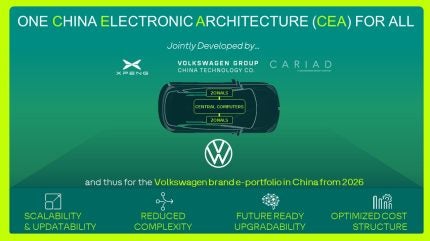
Volkswagen Group China announced that it plans to significantly expand the use of its “zonal” electrical/electronic architecture, the China Electronic Architecture (CEA), which it developed in partnership with local EV manufacturer Xpeng, according to local reports.
Volkswagen Group China confirmed it plans to broaden the use of its CEA beyond the initially planned battery electric vehicles (BEVs) to also include internal combustion engine (ICE) and hybrid vehicle models from 2027. The company recently revealed plans to launch 30 new energy vehicle (NEV) models in China by the end of 2027, and 30 BEV models under its VW and Audi brands in the country by 2030.

Discover B2B Marketing That Performs
Combine business intelligence and editorial excellence to reach engaged professionals across 36 leading media platforms.
The CEA platform, which uses a centralised processing unit, supports advanced driving assistance and smart cockpit systems, including an AI-powered in-car assistant, and can be updated over the air at any time. This architecture also helps cut costs by reducing the number of electronic control units (ECUs) and simplifying overall system complexity.
The decision to expand the use of the CEA architecture means Volkswagen will strengthen its collaboration with Xpeng, as it steps up its “In China, For China” strategy. The company has significantly strengthened its local R&D operations in recent years.
Volkswagen Group China’s CEO, Ralf Brandstaetter, said in a statement: “By extending the CEA to our robust combustion engine fleet, we are strengthening our technological leadership in the conventional powertrain sector and at the same time, we are systematically reducing our cost base, enabling us to continue offering highly attractive choices to customers in China’s intensely competitive automotive market.”






